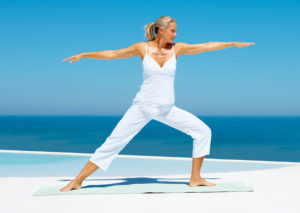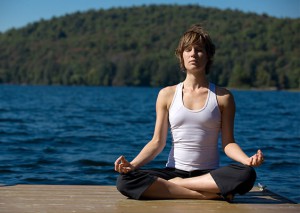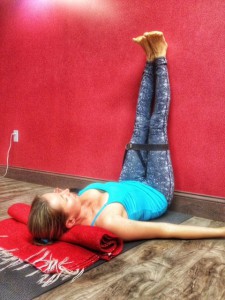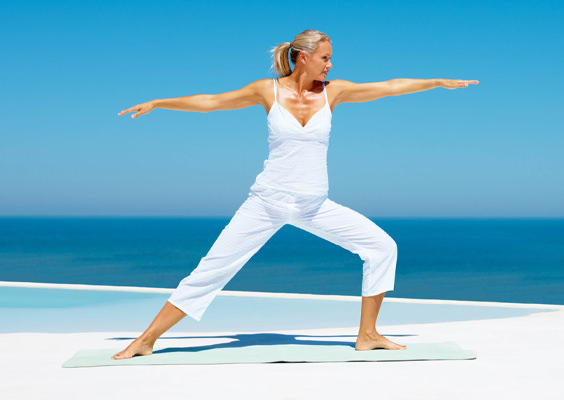
When you feel her calming energy, you would never guess Kata went through a crippling car accident that left her in constant pain.
At the time, the damage to her neck and spine was so severe, her doctors started preparing her for multiple surgeries. They told her she’d be in a neck brace for the rest of her life.
But today, Kata is living pain free. Her spine is long and relaxed, and she has full range of motion in her neck.
And she did it without surgery.
Instead of going under the knife, Kata turned to yoga.
What Is Yoga?
Yoga is a mind-body practice that combines stretching exercises, controlled breathing and relaxation. It can help reduce stress, lower blood pressure and improve heart function.

This 5,000-plus-year-old pursuit not only repaired the damage to the curve of her spine and freed her of pain, it changed her life.
Within months, Kata, a former accountant, became an optimist again. Yoga also gave her sharper mental focus, the skill to better handle everyday challenges, and the ability to respond to life in “a more joyful way,” as she puts it.
Most doctors think of yoga as “light stress relief,” and a way to stay flexible.
But yoga not only heals your injuries, it reverses the biological age of your
cells, tissues, and organs.Today, I’ll introduce you to the anti-aging powers of yoga, and show you an easy but very effective position you can practice at home right now.
East Meets West For A More Energetic Life
In her own words, “Yoga is not an overnight miracle cure, it’s a journey — and the effects last a lifetime. But even in a week or a few days, you’ll feel better.”
“It’s all about linking your breathing to the movements of your body. Most people breathe in a very shallow way. But when you breathe deeply, it changes everything — your body and mind.”
As an anti-aging physician, I know lung power is one of the best predictors of how long you’ll live. So bringing more awareness to your breath is essential in anti-aging medicine.
How Well You Breathe Determines How Long You’ll Stay Active And Healthy.
The medical journal Chest did a 29-year follow-up to the Buffalo Health Study, which followed over 1,100 people up to age 89. The researchers found that the better your lungs work, the less likely you are to die of any cause. The correlation was even stronger for heart disease.i
What’s more, scientific studies show yoga can reverse heart disease. One study, the Lifestyle Heart Trial, found that yoga shrinks the fatty plaque deposits that block coronary arteries.ii
And yoga de-stresses you by increasing levels of the brain-chemical GABA (gamma-aminobutyric acid), which you need for a calm mind.iii
What Are The Anti-Aging Benefits Of Yoga?
The list of yoga’s anti-aging benefits is long.iv It can:
- Boost your immune system;
- Reduce blood pressure;
- Regulate hormones;
- Aid digestion;
- Improve sleep;
- Make your mind sharp and focused;
- Decrease anxiety and increase inner happiness;
- Decrease anxiety and increase inner happiness;
- Relieve arthritis pain;
- Relieve chronic fatigue.
Kata added: “Yoga helps you learn about yourself and listen to your body. It increases your flexibility, releases stress, teaches you how to handle challenges, grasp opportunities and respond to life in a more joyful way.”
Research also shows that yoga has a direct anti-aging impact on your cells. And the good news is that it works for everyone — no matter how old you are. Kata told me she has students in their 70s, 80s and even 90s, who all live healthy, youthful lives — thanks to yoga.
One study published earlier this year revealed that practicing yoga slows the effects of aging by increasing the amount of the enzyme telomerase, which affects the age of your cells.
Telomerase stimulates the growth and rebuilding of your telomeres. And the longer your telomeres, the younger your biological age and the younger you feel.
But yoga not only slows the aging process. It delays and even prevents the onset of disease, because it reduces oxidative stress and inflammation on your cells — the chief cause of most chronic diseases.
Kata’s Favorite Anti-Aging Yoga Position
As Kata points out, yoga “is for everyone — no matter what your age or condition.”
Here’s her favorite “starting position.” It’s a great stress-reliever and will have lasting anti-aging effects on your body.
It’s called Legs Up the Wall. This “therapeutic pose” is a restorative and gentle inversion that helps to promote balance and well-being throughout your entire body.
Beginners may find this position more relaxing with a support — either a firm, long pillow or two folded blankets.

- Set your support 5-10 inches away from the wall, depending on your comfort. Face the wall with your feet on the floor in front of you and the support behind you.
- Shift your lower back onto the support. Now roll onto your back and swing your legs up the wall. (Try various support heights to discover which is most comfortable. Those with stiffer bodies should try a lower support or move further from the wall.)
- Once in position, your legs will be almost vertical. A belt can be used around your thighs or above your knees to hold your legs in place. This allows them to relax more easily.
- Rest your shoulders and head on the floor. Roll up a small towel and place it under the base of your neck. Let your hands rest on your belly or by your sides, palms upward.
- Now close your eyes and breathe deeply through your nose. Soften your face and your throat. Relax your body fully and focus on your breathing.
- Feel the release of anxiety and tension with each breath. It will start in your feet and move through your whole body. Enjoy this posture for 15 minutes.
- To come out of the position, push your feet into the wall and lift your pelvis slightly. Slide off the support and place it to one side. Lower your pelvis to the floor and gently roll to the side. Lie on your side for a few breaths then rise slowly to your feet.
Kata added that this posture is not recommended if you suffer from glaucoma or other eye problems, heart problems, serious neck injury, hiatal hernia or spondylolisthesis — or after the third month of pregnancy.
To Your Good Health,

Al Sears, MD, CNS
iSchünemann, Holger J., MD, PhD et al, “Pulmonary Function Is a Long-term Predictor of Mortality in the General Population,” Chest Sept. 2000; 118( 3): 656-664
iiD Ornish, MD, et al. Can lifestyle changes reverse coronary heart disease?: The Lifestyle Heart Trial. The Lancet. Volume 336, Issue 8708, 21 July 1990, Pages 129–133
iiiStreeter CC1, Jensen JE, Perlmutter RM, Cabral HJ, Tian H, Terhune DB, Ciraulo DA, Renshaw PF.Yoga Asana sessions increase brain GABA levels: a pilot study. J Altern Complement Med. 2007 May;13(4):419-26.
ivStreeter CC, Gerbarg PL, Saper RB, Ciraulo DA, Brown RP. Effects of yoga on the autonomic nervous system, gamma-aminobutyric-acid, and allostasis in epilepsy, depression, and post-traumatic stress disorder. Med Hypotheses. 2012 May;78(5):571-9. doi: 10.1016/j.mehy.2012.01.021. Epub 2012 Feb 24.
vKumar SB, Yadav R, Yadav RK, Tolahunase M, Dada R. Telomerase activity and cellular aging might be positively modified by a yoga-based lifestyle intervention. J Altern Complement Med. 2015 Jun;21(6):370-2. doi: 10.1089/acm.2014.0298. Epub 2015 May 12.

